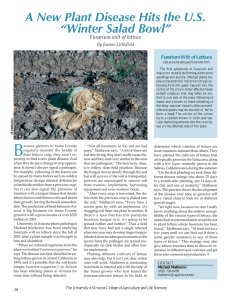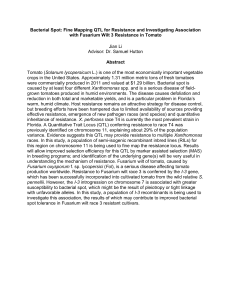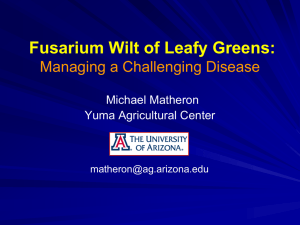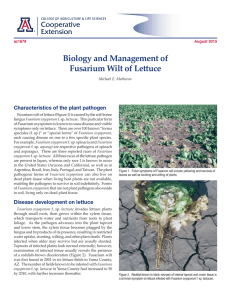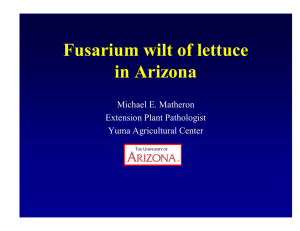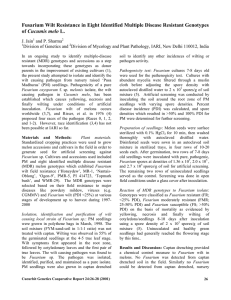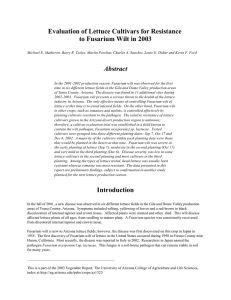Project Title: Project Leader:
advertisement
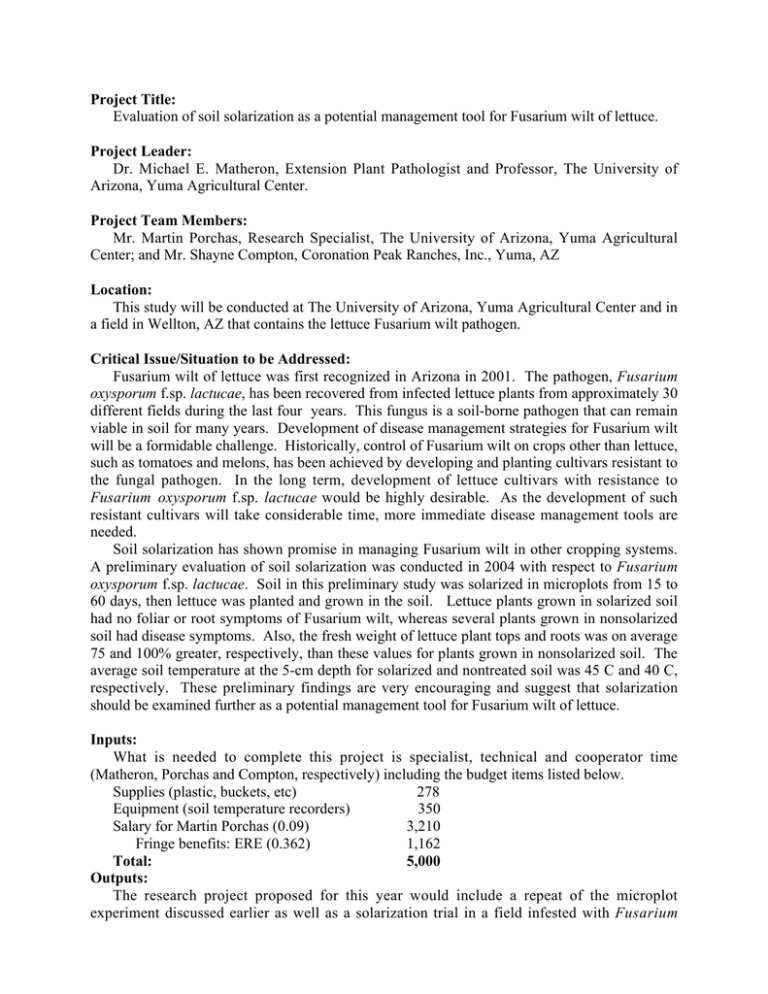
Project Title: Evaluation of soil solarization as a potential management tool for Fusarium wilt of lettuce. Project Leader: Dr. Michael E. Matheron, Extension Plant Pathologist and Professor, The University of Arizona, Yuma Agricultural Center. Project Team Members: Mr. Martin Porchas, Research Specialist, The University of Arizona, Yuma Agricultural Center; and Mr. Shayne Compton, Coronation Peak Ranches, Inc., Yuma, AZ Location: This study will be conducted at The University of Arizona, Yuma Agricultural Center and in a field in Wellton, AZ that contains the lettuce Fusarium wilt pathogen. Critical Issue/Situation to be Addressed: Fusarium wilt of lettuce was first recognized in Arizona in 2001. The pathogen, Fusarium oxysporum f.sp. lactucae, has been recovered from infected lettuce plants from approximately 30 different fields during the last four years. This fungus is a soil-borne pathogen that can remain viable in soil for many years. Development of disease management strategies for Fusarium wilt will be a formidable challenge. Historically, control of Fusarium wilt on crops other than lettuce, such as tomatoes and melons, has been achieved by developing and planting cultivars resistant to the fungal pathogen. In the long term, development of lettuce cultivars with resistance to Fusarium oxysporum f.sp. lactucae would be highly desirable. As the development of such resistant cultivars will take considerable time, more immediate disease management tools are needed. Soil solarization has shown promise in managing Fusarium wilt in other cropping systems. A preliminary evaluation of soil solarization was conducted in 2004 with respect to Fusarium oxysporum f.sp. lactucae. Soil in this preliminary study was solarized in microplots from 15 to 60 days, then lettuce was planted and grown in the soil. Lettuce plants grown in solarized soil had no foliar or root symptoms of Fusarium wilt, whereas several plants grown in nonsolarized soil had disease symptoms. Also, the fresh weight of lettuce plant tops and roots was on average 75 and 100% greater, respectively, than these values for plants grown in nonsolarized soil. The average soil temperature at the 5-cm depth for solarized and nontreated soil was 45 C and 40 C, respectively. These preliminary findings are very encouraging and suggest that solarization should be examined further as a potential management tool for Fusarium wilt of lettuce. Inputs: What is needed to complete this project is specialist, technical and cooperator time (Matheron, Porchas and Compton, respectively) including the budget items listed below. Supplies (plastic, buckets, etc) 278 Equipment (soil temperature recorders) 350 Salary for Martin Porchas (0.09) 3,210 Fringe benefits: ERE (0.362) 1,162 Total: 5,000 Outputs: The research project proposed for this year would include a repeat of the microplot experiment discussed earlier as well as a solarization trial in a field infested with Fusarium oxysporum f.sp. lactucae. For the microplot study, soil naturally infested with this pathogen, collected in mid-July from a commercial field in Wellton, AZ, would be placed in containers (5gallon buckets) that are buried in a field at the Yuma Mesa Agricultural Center so that the upper lip of each bucket is level with the soil surface. Each bucket will be considered a replicate microplot. Soil in each microplot container will be thoroughly irrigated, covered with clear plastic for 15, 30, 45 or 60 days, then tested for the presence of the fungal pathogen by sowing and growing lettuce plants in this soil. Five replicate microplots will be established for each of the four soil solarization periods. The control treatment will consist of five replicate buckets containing dry soil not covered with plastic. Soil temperature will be recorded at a depth of 5and 23-cm within microplots to be solarized or to serve as a control. The field trial will be conducted at the same location where soil was collected for the microplot study. A wheat crop is currently growing in this field. After harvest, wheat residue will be incorporated into the soil and lettuce planting beds will be prepared. After the field is irrigated, five 200-ft. lengths of bed will be covered with a clear plastic beginning in mid-July. Five beds of the same length not covered with clear plastic will serve as controls. At 15, 30, 45 and 60 days after plastic was initially placed on beds, a 50-ft section of plastic will be removed from each bed, resulting in 50-ft lengths of bed subjected to solarization for 15, 30, 45 and 60 days. In mid-September, all beds will be planted to lettuce and the incidence and severity of Fusarium wilt will be recorded until plant maturity in December. Soil temperature at a depth of 5- and 23-cm in solarized and untreated beds will be recorded. University of Arizona research and technical personnel as well as a grower cooperator will be involved in this cooperative project. Outcomes: The expected short-term results from this project include collection of microplot and field data that should demonstrate the potential utility of a soil solarization treatment for reducing the incidence and severity of Fusarium wilt of lettuce. These findings can then be used in outreach efforts (meeting presentations, articles, etc) to educate clientele concerning the value of this disease management tool. Depending upon the degree of disease reduction realized, the results of this project could stimulate interest among lettuce growers with fields infested with Fusarium oxysporum f. sp. lactucae to evaluate this disease management tool for themselves. The degree of success in reducing Fusarium wilt of lettuce, as evidenced by the collected data, will be a means of evaluating this project to determine degree of success in achieving our desired outcomes. The success in encouraging growers to try solarization as a lettuce Fusarium wilt management tool will be shown by the number of growers that try this technology in their own fields.
